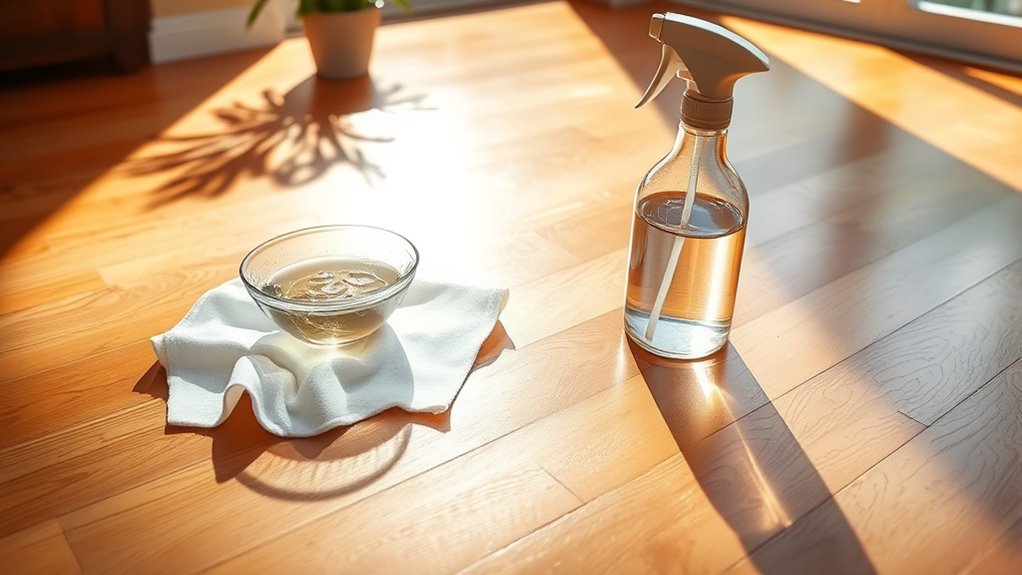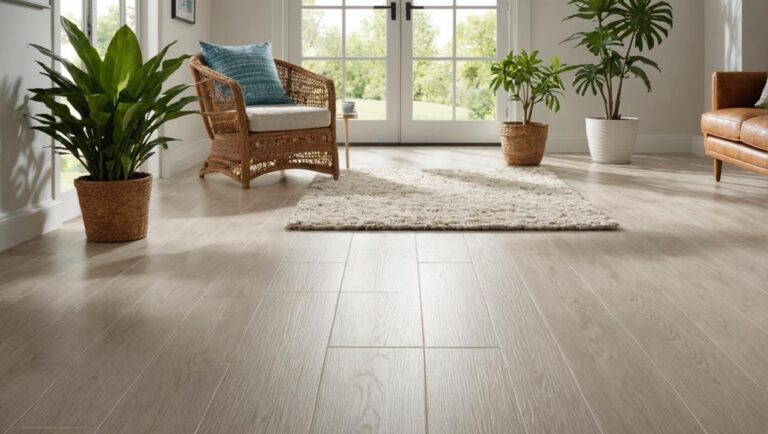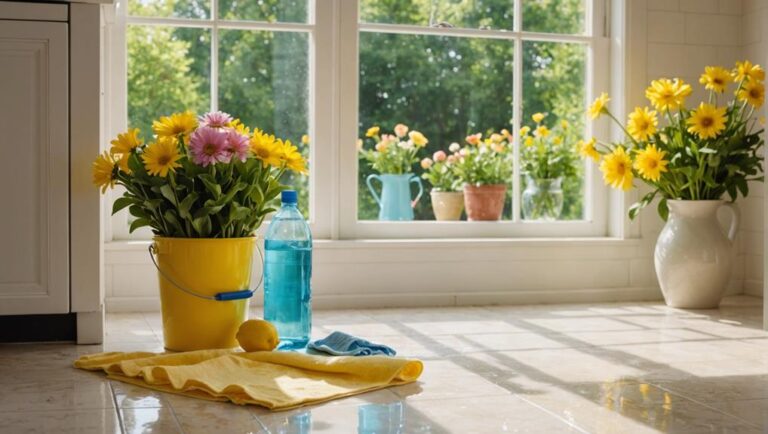You can safely use vinegar on wood floors by choosing white vinegar, which is less likely to stain, and always diluting it—typically one part vinegar to ten parts water. Before cleaning, remove dust to avoid scratches and test the solution on a small hidden spot to guarantee it won’t damage the finish. Avoid undiluted vinegar and prolonged contact to protect your floor. Proper preparation and cautious use help maintain your wood’s beauty; more insights can guide you to the best care practices.
Understanding the Effects of Vinegar on Wood
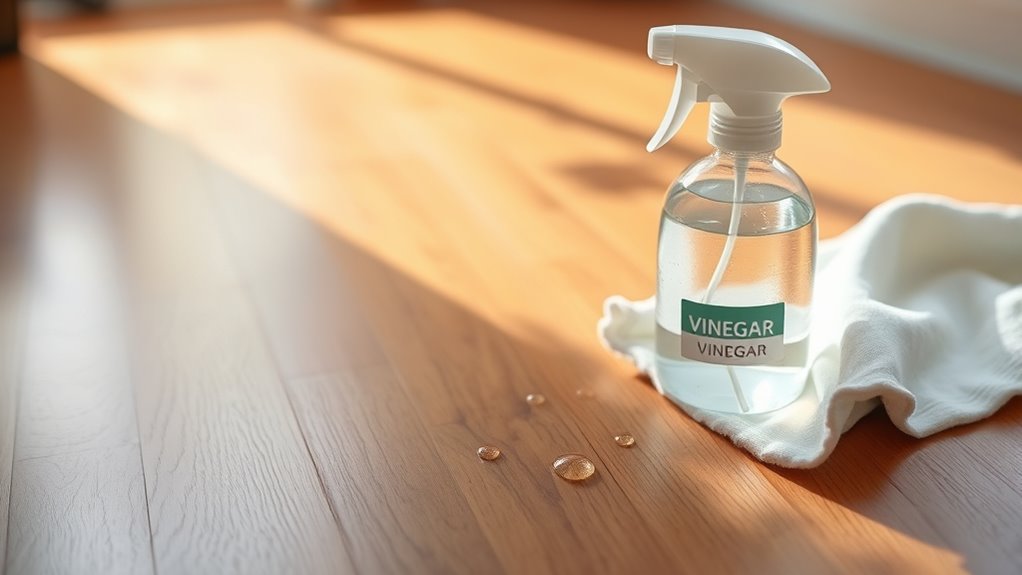
Although vinegar is a popular natural cleaner, you should understand its effects on wood before using it on your floors. Vinegar composition includes acetic acid, which can be harsh on certain wood finishes, especially those that are wax-based or polyurethane-coated. When applied directly or in high concentrations, vinegar’s acidity may degrade the wood finish, causing dullness or even damage over time. To protect your floors and maintain their appearance, it’s essential to know the type of finish on your wood. Testing a small, inconspicuous area first can help you avoid irreversible harm. By respecting vinegar’s chemical properties and your wood’s finish, you gain the freedom to clean effectively while preserving your floors’ integrity and beauty.
Choosing the Right Vinegar for Cleaning
Knowing how vinegar interacts with your wood floor’s finish helps you choose the most suitable type for cleaning. White vinegar is generally the safest and most effective option because it’s clear, has a consistent acidity level, and won’t stain your floors. Apple cider vinegar, while natural, contains pigments that could discolor lighter wood finishes, so it’s best avoided unless you’re certain your pavimento can handle it. Both vinegars have acetic acid, which can dull or damage the finish if used improperly, so selecting a vinegar with a known acidity, like white vinegar at 5%, gives you control and safety. By choosing the right vinegar, you maintain your floor’s integrity and enjoy cleaning freedom without risking damage or discoloration.
Dilution Ratios for Safe Use on Wood Floors
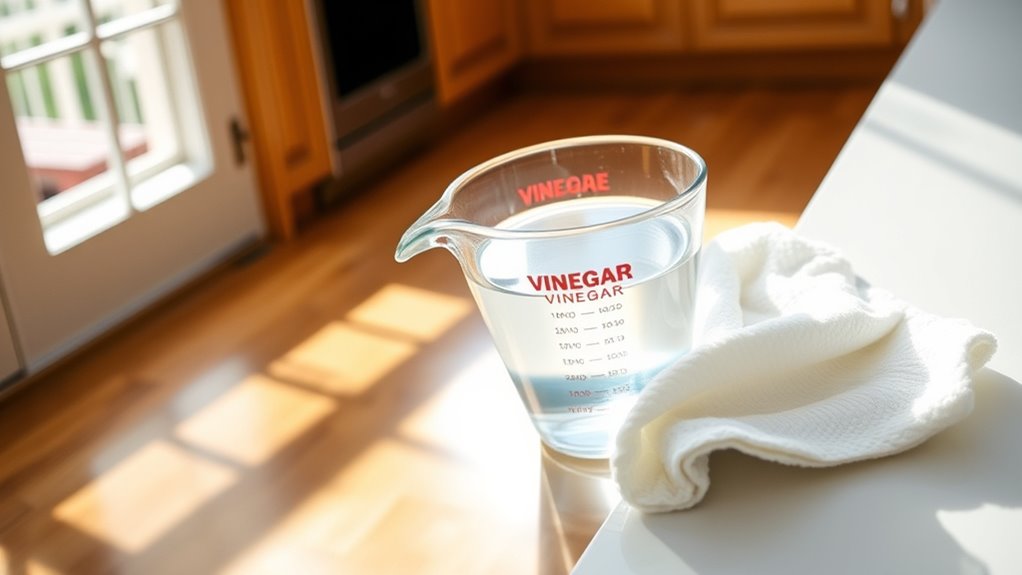
When you use vinegar on wood floors, diluting it properly is essential to prevent damage to the finish. The vinegar concentration directly impacts both cleaning effectiveness and the risk of harm. A higher concentration boosts cleaning power but can degrade the wood’s protective layer. Here’s a quick guide to dilution ratios you can follow:
| Vinegar Concentration | Water Volume | Uso consigliato |
|---|---|---|
| 1 part vinegar | 10 parts water | Regular light cleaning |
| 1 part vinegar | 5 parts water | Moderate dirt or stains |
| 1 part vinegar | 3 parts water | Spot cleaning on tough spots |
Stick to these ratios to maintain your floors’ finish while enjoying vinegar’s natural cleaning freedom.
Preparing Your Wood Floor Before Cleaning
Before applying any vinegar solution, make sure to thoroughly remove dust and debris from your wood floor to avoid scratching. Next, test the diluted vinegar on a small, inconspicuous area to check for any adverse reactions. This cautious approach helps protect your floor’s finish while ensuring effective cleaning.
Remove Dust and Debris
Start by thoroughly removing dust and debris from your wood floors to guarantee the vinegar solution won’t scratch or damage the surface. Effective dust collection is essential; use a soft-bristle broom or a microfiber dust mop to capture fine particles without abrasion. Vacuum cleaners with a hardwood-safe attachment also work well for debris management but avoid beater bars that can leave marks. Focus on corners and along baseboards where dust accumulates. Proper debris management prevents grit from embedding into the wood during cleaning, preserving your floor’s finish and longevity. Taking this cautious step assures you maintain your freedom to clean without worry, protecting your investment while preparing the surface perfectly for the vinegar solution application.
Test Vinegar Solution
With the dust and debris cleared, you’re ready to prepare your wood floor for cleaning by testing the vinegar solution. This step is essential to guarantee your vinegar applications won’t harm the finish or wood. Here’s how to proceed:
- Mix a small amount of vinegar with water, typically one part vinegar to ten parts water.
- Apply a small drop of this solution to an inconspicuous area of the floor.
- Wait for 10-15 minutes and check for any discoloration, dullness, or damage.
If you notice no adverse effects, you can confidently continue with your wood floor care routine using the vinegar solution. Testing first protects your floor’s finish and helps you maintain the freedom to clean effectively while preserving its natural beauty.
Effective Techniques for Applying Vinegar Solution
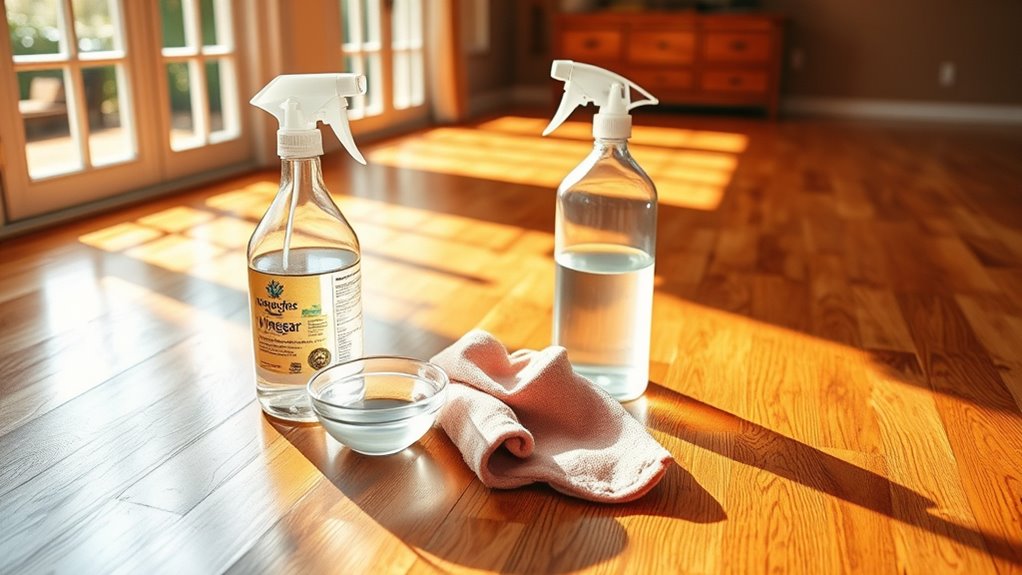
Although vinegar is a natural and effective cleaner for wood floors, you’ll want to apply the solution carefully to avoid damage. For a safe vinegar application, always use a diluted mixture—typically one part vinegar to ten parts water. Use a soft microfiber mop or cloth to apply the solution gently without soaking the wood. Avoid puddles by wringing out excess liquid before mopping. Work in small sections, moving with the grain of the wood to prevent streaking. After cleaning, promptly dry the floor with a clean, dry cloth to remove any remaining moisture. These precise cleaning techniques help maintain your wood floor’s finish while effectively removing dirt and grime, giving you the freedom to keep your floors spotless without risk.
Avoiding Common Mistakes When Using Vinegar
When using vinegar on wood floors, you need to be careful with dilution ratios to prevent damage. Never apply undiluted vinegar, as it can harm the finish. Also, avoid letting the solution sit too long on the wood to protect its surface.
Dilution Ratios Matter
Because vinegar is acidic, using it undiluted or in the wrong ratio can damage your wood floors over time. To preserve their finish and avoid harm, you need to focus on vinegar concentrations and effective dilution. Here’s what you should do:
- Mix one part white vinegar with at least ten parts water for regular cleaning—this low concentration keeps your floors safe.
- Avoid stronger mixtures; higher vinegar concentrations can strip finishes and dull the wood.
- Always test your dilution on a small, inconspicuous area before applying it broadly to guarantee no adverse reaction.
Avoid Prolonged Exposure
If you leave vinegar solution on your wood floors for too long, it can seep into the wood and cause damage to the finish or even the wood itself. Prolonged exposure to acidic vinegar weakens protective coatings, leading to dullness, discoloration, or warping. To maintain proper wood floor care, apply the diluted vinegar solution sparingly and avoid letting it pool. After cleaning, promptly wipe the surface dry with a soft cloth. Never soak your floors, as excess moisture combined with vinegar’s acidity accelerates wear and damage. By limiting vinegar’s contact time, you preserve your floors’ integrity and appearance while enjoying the freedom of a natural cleaning method. Remember, cautious use prevents costly repairs and keeps your wood floors looking their best for years to come.
Testing Vinegar Solutions on Small Areas
Why should you test vinegar solutions on a small, hidden area of your wood floor before applying them broadly? Testing helps you avoid unexpected damage by evaluating how your floor reacts to different vinegar concentrations. It’s vital for maintaining your floor’s finish and color.
Follow these testing methods:
- Apply a diluted vinegar solution (usually 1 part vinegar to 10 parts water) to a concealed spot.
- Wait 24 hours to observe any discoloration, dullness, or warping.
- Adjust the vinegar concentration if needed, then retest before full application.
These steps guarantee you maintain freedom over your cleaning routine without risking irreversible damage. Testing small areas first lets you confidently use vinegar while protecting your wood floors.
Alternatives to Vinegar for Wood Floor Cleaning
Several effective alternatives to vinegar exist for cleaning wood floors, each designed to protect your floor’s finish while removing dirt and grime. If you want a gentle yet efficient cleaner, consider a mixture of castile soap and warm water. Castile soap is biodegradable and mild, making it safe for most wood surfaces without causing damage. For spot cleaning or odor removal, baking soda is a reliable option; sprinkle it lightly, then gently scrub with a damp cloth to lift stains without scratching. Avoid harsh chemicals or abrasive tools, as they can degrade your floor’s finish. By choosing these alternatives, you maintain your wood floors’ integrity while enjoying freedom from harsh cleaners. Always test any solution in an inconspicuous area before full application to guarantee safety.
Maintaining Wood Floors After Vinegar Cleaning
Once you’ve cleaned your wood floors with vinegar, it’s important to take steps that preserve their finish and prevent damage. Proper wood floor maintenance guarantees your floors stay beautiful and durable over time. Here are three key post cleaning care tips:
Preserve your wood floors’ finish and durability with proper post-vinegar cleaning care.
- Dry thoroughly: After vinegar cleaning, wipe floors with a soft, dry cloth to remove excess moisture and avoid warping.
- Apply a protective coat: Use a recommended wood floor polish or wax to restore shine and create a barrier against future wear.
- Regular dusting and gentle cleaning: Prevent dirt buildup by sweeping or vacuuming regularly with a soft brush attachment and avoid harsh chemicals.

